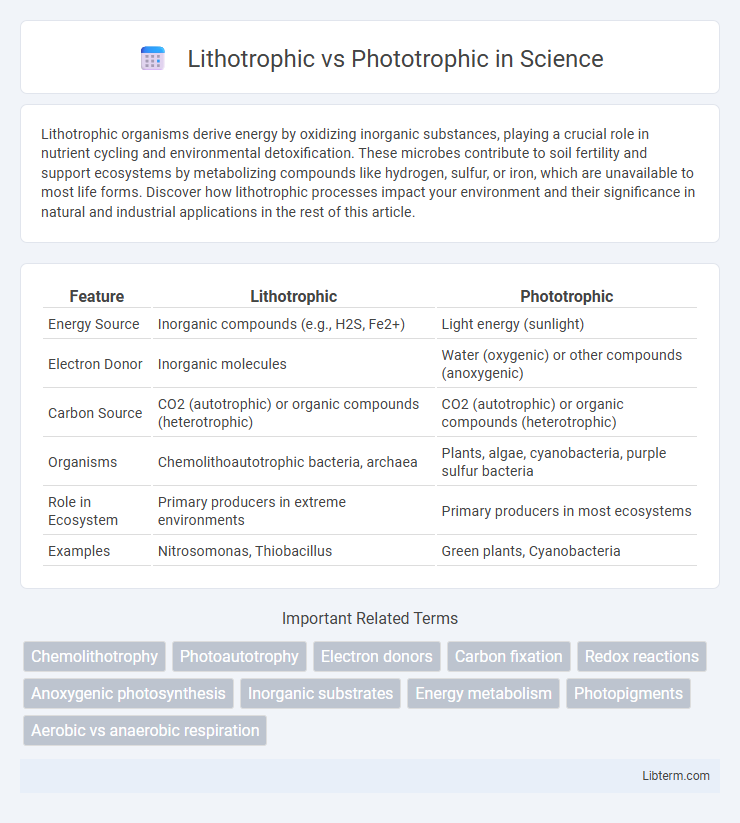Lithotrophic organisms derive energy by oxidizing inorganic substances, playing a crucial role in nutrient cycling and environmental detoxification. These microbes contribute to soil fertility and support ecosystems by metabolizing compounds like hydrogen, sulfur, or iron, which are unavailable to most life forms. Discover how lithotrophic processes impact your environment and their significance in natural and industrial applications in the rest of this article.
Table of Comparison
| Feature | Lithotrophic | Phototrophic |
|---|---|---|
| Energy Source | Inorganic compounds (e.g., H2S, Fe2+) | Light energy (sunlight) |
| Electron Donor | Inorganic molecules | Water (oxygenic) or other compounds (anoxygenic) |
| Carbon Source | CO2 (autotrophic) or organic compounds (heterotrophic) | CO2 (autotrophic) or organic compounds (heterotrophic) |
| Organisms | Chemolithoautotrophic bacteria, archaea | Plants, algae, cyanobacteria, purple sulfur bacteria |
| Role in Ecosystem | Primary producers in extreme environments | Primary producers in most ecosystems |
| Examples | Nitrosomonas, Thiobacillus | Green plants, Cyanobacteria |
Introduction to Lithotrophic and Phototrophic Organisms
Lithotrophic organisms derive energy by oxidizing inorganic molecules such as hydrogen sulfide, ammonia, or ferrous iron, playing a crucial role in biogeochemical cycles like nitrogen and sulfur cycling. Phototrophic organisms utilize light energy through photosynthesis, converting carbon dioxide and water into organic compounds, and are essential primary producers in ecosystems. Both lithotrophic and phototrophic organisms contribute significantly to energy flow and nutrient cycling in various environmental niches, supporting diverse microbial communities.
Defining Lithotrophy: Energy from Inorganic Sources
Lithotrophy refers to a metabolic process where organisms obtain energy by oxidizing inorganic compounds such as hydrogen sulfide, ammonia, or ferrous iron. These lithotrophs use chemical energy derived from inorganic molecules to drive cellular activities, differing fundamentally from phototrophs that rely on light energy for photosynthesis. Unlike phototrophic organisms, lithotrophs thrive in environments lacking sunlight, playing crucial roles in biogeochemical cycles by converting inorganic substrates into usable energy forms.
Understanding Phototrophy: Harnessing Light for Life
Phototrophy is the process by which organisms convert light energy into chemical energy, primarily through photosynthesis, enabling the synthesis of organic compounds essential for growth. Phototrophic organisms, such as cyanobacteria and algae, utilize pigments like chlorophyll to capture sunlight, driving the production of ATP and NADPH. Unlike lithotrophic organisms that derive energy from inorganic chemical substrates, phototrophs fundamentally depend on light as their energy source, playing a critical role in energy flow and carbon fixation in ecosystems.
Major Differences Between Lithotrophs and Phototrophs
Lithotrophs obtain electrons from inorganic compounds such as hydrogen sulfide or ferrous iron, whereas phototrophs capture light energy through pigments like chlorophyll to drive their metabolic processes. Lithotrophs primarily rely on chemical energy from oxidation-reduction reactions, while phototrophs use light energy for photosynthesis to convert carbon dioxide into organic matter. The ecological roles differ as lithotrophs often inhabit environments with abundant inorganic substrates, whereas phototrophs dominate in sunlit habitats contributing significantly to primary production.
Ecological Roles of Lithotrophic Organisms
Lithotrophic organisms play a critical role in ecosystems by driving nutrient cycling through the oxidation of inorganic compounds such as hydrogen sulfide, ammonia, and ferrous iron. These microbes contribute to soil formation, detoxification of environments, and support of primary production in extreme habitats like hydrothermal vents and acidic springs. Their metabolic activities maintain the balance of essential elements, enabling the survival of diverse biological communities.
The Importance of Phototrophs in Ecosystems
Phototrophic organisms, including plants, algae, and cyanobacteria, play a critical role in ecosystems by converting solar energy into chemical energy through photosynthesis, producing oxygen and organic compounds essential for other life forms. These primary producers form the foundation of most food webs, supporting heterotrophic organisms and sustaining biodiversity. In contrast, lithotrophs derive energy from inorganic compounds and contribute significantly to nutrient cycling but do not directly influence atmospheric oxygen levels or carbon fixation at the scale of phototrophs.
Energy Acquisition Pathways: Lithotrophic vs Phototrophic
Lithotrophic organisms acquire energy by oxidizing inorganic molecules such as hydrogen sulfide, ammonia, or ferrous iron, enabling them to thrive in environments lacking sunlight. Phototrophic organisms harness light energy through photosynthesis, using pigments like chlorophyll to convert solar energy into chemical energy. These distinct energy acquisition pathways define their ecological roles and metabolic adaptations, with lithotrophs relying on chemical electron donors and phototrophs exploiting light as the primary energy source.
Examples of Lithotrophic and Phototrophic Microbes
Lithotrophic microbes, such as Nitrosomonas and Acidithiobacillus, obtain energy by oxidizing inorganic compounds like ammonia and sulfur, commonly found in soil and aquatic environments. Phototrophic microbes, including cyanobacteria and purple sulfur bacteria, harness sunlight for photosynthesis, converting light energy into chemical energy while producing oxygen or sulfur compounds. These metabolic pathways enable lithotrophs to thrive in extreme environments and phototrophs to play essential roles in carbon fixation and oxygen production.
Industrial and Environmental Applications
Lithotrophic microorganisms play a crucial role in bioleaching and bioremediation by oxidizing inorganic substances to extract metals and degrade pollutants in mining and wastewater treatment industries. Phototrophic organisms contribute significantly to sustainable bioenergy production through photosynthesis, enabling the generation of biomass and biofuels while reducing carbon emissions. The integration of lithotrophic and phototrophic processes enhances environmental management strategies by facilitating nutrient cycling and promoting eco-friendly industrial applications.
Future Research and Emerging Discoveries
Emerging discoveries highlight the potential of lithotrophic microorganisms in bioremediation and sustainable bioenergy production, driven by their ability to oxidize inorganic substrates under extreme conditions. Future research aims to elucidate the genetic and enzymatic pathways enabling phototrophic bacteria to harness light energy more efficiently, enhancing applications in biofuel synthesis and carbon capture. Integrating metagenomics and synthetic biology approaches promises to expand understanding of metabolic versatility and optimize microbial communities for environmental and industrial biotechnology.
Lithotrophic Infographic

 libterm.com
libterm.com